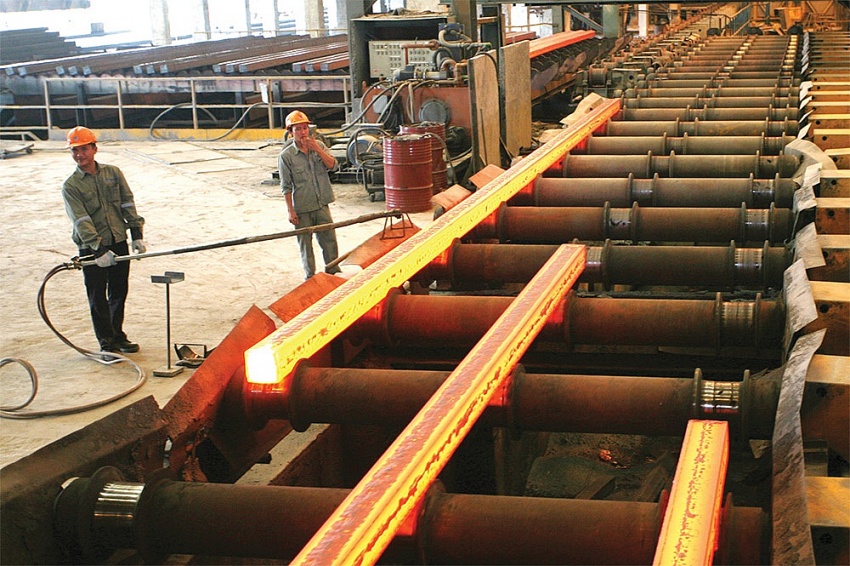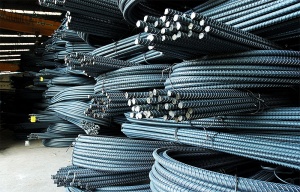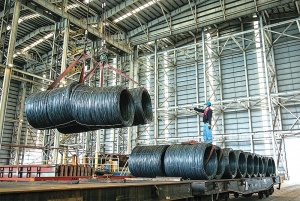Huge capital currently out of reach for steel transition
Le Quan, deputy general director of a state-owned steel making company, told a discussion on decarbonising the Vietnamese steel industry held last week by the German Embassy to Vietnam that it would be “impossible” for the industry to become decarbonised at least within a decade.
“I would say that we can never decarbonise steel making plants now due to so many obstructions,” Quan said. “The obstructions are about capital, high technologies, and especially the difficult shift to other types of energy used for heating furnaces.”
According to Cécile Seguineaud, an industry policy analyst at Clean Energy Finance and Investment Mobilisation under the Organisation for Economic Co-operation and Development, 90 per cent of steel produced globally comes from nations that have made commitments on net-zero emissions by 2050. About 30 per cent of global steelmakers have also committed to achieve net-zero emissions.
“However, the volume of steel really produced by high technologies under net-zero commitments in the global market accounts for only 1 per cent,” Seguineaud said. “Now it may need about $1.5 trillion to decarbonise the global steel industry – quite a huge volume of capital.”
 |
| Huge capital currently out of reach for steel transition |
Meanwhile in Vietnam, there is no specific strategy on steel industry development available, not to mention the total capital needed for the domestic steel industry to decarbonise itself.
“It is now quite difficult to manage steel projects in terms of emissions and outputs,” said Chu Hoang Duc Anh, a representative from the Vietnam Industry Agency under the Ministry of Industry and Trade (MoIT). “Almost all steel projects in Vietnam now don’t use modern technologies, with coal used as input for heating the plants, causing environmental pollution.”
According to the MoIT, as the steel industry is of great importance to a wide range of other industrial sectors including construction, manufacturing, mobility, and infrastructure, steel production is projected to grow, continuing to be of great economic and developmental significance, particularly in emerging economies. Last year, the industry produced 19.2 million tonnes of raw steel and 27.76 million tonnes of fished products.
As Vietnam ranks 13th among the largest crude steel producers and leads ASEAN in both production and consumption of steel products, the industry remains one of the main contributors to the country’s carbon emissions.
It is estimated that the industry will emit about 122.5 million tonnes of CO2 by 2025 from an estimated 120 million last year, and 132.9 million by 2030, accounting for about 17 per cent of the country’s total emissions.
“The biggest impediments now for the industry is to change heating materials, meaning changing from coal to other types of environmental-friendly energy such as hydrogen,” said Prof. Dr. Bui Anh Hoa, head of the School of Materials Science and Engineering under the Hanoi University of Science and Technology. “Meanwhile, production of hydrogen energy remains limited in Vietnam due to high costs and high technologies used. Thus it is almost impossible for the industry to become carbon-neutral over the next decades.”
Jennifer Pham, regional advisor on sustainable value chains at the Danish Embassy to Vietnam, underlined that if the Vietnamese steel industry fails to become decarbonised, it would be hard to boost export steel products in the long term to the EU, which is now applying the Carbon Border Adjustment Mechanism (CBAM).
“The CBAM will impact on goods prices and may reduce the competitiveness of products,” Pham said. “That’s why exporters must have full understanding about it.”
Figures from the General Department of Vietnam Customs showed that last year, Vietnam exported more than 2.5 million tonnes of assorted steel products to the EU, doubling 2022, and accounting for 23 per cent of the country’s total export volume.
However, from mid-2023, exports to the EU market faced two major barriers: safeguard measures and the CBAM.
The CBAM aims to levy a carbon tax on all goods imported into EU markets, based on the intensity of greenhouse gas emissions in the host country’s production process.
Currently, this mechanism is in phase 1 when exporters, including steel ones, have to declare emission levels. Nevertheless, when the mechanism embarks upon the next stage, steel firms in Vietnam will have to buy CBAM emission certificates from 2026.
“This will drive production costs up and reduce competitiveness if manufacturers fail to cut down emissions during production activities,” said Pham Cong Thao, deputy general director of Vietnam Steel Corporation (VNSteel).
VNSteel reported that in Q1, its consumption of finished steel products reached over 724,500 tonnes, up 9 per cent on-year. In March alone, the figure hit more than 243,100 tonnes, including long shaft steel standing at 143,700 tonnes, cold-rolled steel sitting at 70,700 tonnes, and coated sheets at 28,600 tonnes.
According to the MoIT’s Vietnam Institute of Strategy and Policy for Industry and Trade, under the impact of the CBAM, the Vietnamese steel industry is anticipating a roughly 4 per cent reduction in its export value, leading to a decrease in output of around 0.8 per cent, coupled with the adverse effects of reduced competitiveness.
The Vietnam Steel Association forecasted that the steel industry is likely to recover weakly in 2024 due to outstanding difficulties in the real estate market. Steel consumption is forecast to increase by 7 per cent to 21.7 million tonnes, and output could reach nearly 29 million tonnes, up 7 per cent from 2023.
 | Steel firms drop prices for the third time this year Construction steel manufacturers are once again reducing prices, with an adjustment of around $4.17/tonne at the beginning of April. |
 | Domestic steel demand expected to rebound amid warming real estate market Domestic steel demand is anticipated to rise this year due to the civil construction recovery and the positive impacts of the global steel market. |
 | Steelmaking can become climate-neutral process Steel is one of the world’s most-used materials and a central part of the global economy. Steel’s carbon footprint touches almost every industry, from automotive and construction to machinery, transportation and energy. This makes steel a global priority for decarbonisation. |
What the stars mean:
★ Poor ★ ★ Promising ★★★ Good ★★★★ Very good ★★★★★ Exceptional
Related Contents
Latest News
More News
- Ho Chi Minh City backs $2 billion AI data centre with dedicated task force (January 06, 2026 | 08:43)
- PM sets January deadline for high-speed rail consultant (January 06, 2026 | 08:40)
- New decree spurs on PPP implementation (December 31, 2025 | 19:01)
- Global alliance develops $1 billion AI data centre network in Vietnam (December 30, 2025 | 10:08)
- Standing out in the Chinese outbound investment wave (December 29, 2025 | 10:29)
- Bright spots obvious in foreign investment mission (December 29, 2025 | 09:00)
- Ho Chi Minh City hits $8.37 billion in FDI (December 29, 2025 | 08:28)
- Vietnam and UK cooperation backs finance talent for IFCs (December 27, 2025 | 16:31)
- Global partnerships key to Vietnam’s IFC development (December 26, 2025 | 16:18)
- Vingroup pulls out of bid to invest in North-South high-speed railway (December 26, 2025 | 11:42)

 Tag:
Tag:





















 Mobile Version
Mobile Version